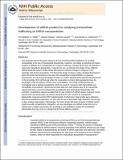Development of siRNA-probes for studying intracellular trafficking of siRNA nanoparticles
Author(s)
Alabi, Christopher A.; Sahay, Gaurav; Anderson, Daniel Griffith; Langer, Robert S
DownloadAnderson_Development of.pdf (1.414Mb)
OPEN_ACCESS_POLICY
Open Access Policy
Creative Commons Attribution-Noncommercial-Share Alike
Terms of use
Metadata
Show full item recordAbstract
One important barrier facing the delivery of short interfering RNAs (siRNAs) via synthetic nanoparticles is the rate of nanoparticle disassembly. However, our ability to optimize the release kinetics of siRNAs from nanoparticles for maximum efficacy is limited by the lack of methods to track their intracellular disassembly. Towards this end, we describe the design of two different siRNA-based fluorescent probes whose fluorescence emission changes in response to the assembly state of the nanoparticle. The first probe design involves a redox-sensitive fluorescence-quenched probe that fluoresces only when the nanoparticle is disassembled in a reductive environment. The second probe design is based on a FRET-labeled siRNA pair that fluoresces due to the proximity of the siRNA pair when the nanoparticle is intact. In both approaches, the delivery vehicle need not be labeled. The utility of these probes was investigated with a lipidoid nanoparticle (LNP) as proof-of-concept in both extracellular and intracellular environments. Fluorescence kinetic data from both probes were fit to a two-phase release and decay curve and subsequently quantified to give intracellular disassembly rate constants. Quantitative analysis revealed that the rate constant of siRNA release measured via the fluorescence-quenched probe was almost identical to the rate constant for nanoparticle disassembly measured via the FRET-labeled probes. Furthermore, these probes were utilized to determine subcellular localization of LNPs with the use of automated high-resolution microscopy as they undergo dissociation. Interestingly, this work shows that large amounts of siRNA remain inside vesicular compartments. Altogether, we have developed new siRNA probes that can be utilized with multiple nanocarriers for quantitative and qualitative analysis of nanoparticle dissociation that may serve as a design tool for future delivery systems.
Date issued
2012-08Department
Harvard University--MIT Division of Health Sciences and Technology; Massachusetts Institute of Technology. Department of Chemical Engineering; Koch Institute for Integrative Cancer Research at MITJournal
Integrative Biology
Publisher
Royal Society of Chemistry
Citation
Alabi, Christopher A., Gaurav Sahay, Robert Langer, and Daniel G. Anderson. “Development of siRNA-Probes for Studying Intracellular Trafficking of siRNA Nanoparticles.” Integr. Biol. 5, no. 1 (2012): 224.
Version: Author's final manuscript
ISSN
1757-9694
1757-9708